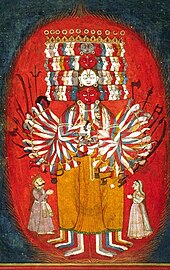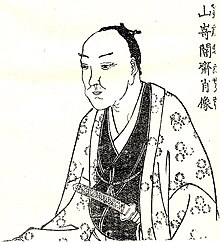Pandeism in Asia
| Part of a series on |
| Theism |
|---|
Pandeism (or pan-deism), a theological doctrine which combines aspects of pantheism into deism,[1] and holds that the creator deity became the universe and ceased to exist as a separate and conscious entity,[2] has been noted by various authors to encompass many religious beliefs found in Asia, with examples primarily being drawn from India and China.
Pandeism in China

Physicist and philosopher Max Bernhard Weinstein in his 1910 work Welt- und Lebensanschauungen, Hervorgegangen aus Religion, Philosophie und Naturerkenntnis ("World and Life Views, Emerging From Religion, Philosophy and Nature"), presented the broadest and most far-reaching examination of pandeism written up to that point. Weinstein found varieties of pandeism in the religious views held in China,[3] especially with respect to Taoism as expressed by Lao-Tze.[4]
Pandeism (in Chinese, 泛自然神论)[5] was described by Wen Chi, in a Peking University lecture, as embodying "a major feature of Chinese philosophical thought," in that "there is a harmony between man and the divine, and they are equal."[6] Zhang Dao Kui (张道葵) of the China Three Gorges University proposed that the art of China's Three Gorges area is influenced by "a representation of the romantic essence that is created when integrating rugged simplicity with the natural beauty spoken about by pandeism."[7] Literary critic Wang Junkang (王俊康) has written that, in Chinese folk religion as conveyed in the early novels of noted folk writer Ye Mei (叶梅),[8] "the romantic spirit of Pandeism can be seen everywhere."[9] Wang Junkang additionally writes of Ye Mei's descriptions of "the worship of reproduction under Pandeism, as demonstrated in romantic songs sung by village people to show the strong impulse of vitality and humanity and the beauty of wildness."[10] It has been noted that author Shen Congwen has attributed a kind of hysteria that "afflicts those young girls who commit suicide by jumping into caves-"luodong" 落洞" to "the repressive local military culture that imposes strict sexual codes on women and to the influence of pan-deism among Miao people," since "for a nymphomaniac, jumping into a cave leads to the ultimate union with the god of the cave" (the cave being a metaphor for death itself).[11]
Pandeism in India

In 1833, religionist Godfrey Higgins theorized in his Anacalypsis that "Pandeism was a doctrine, which had been received both by Buddhists and Brahmins."[12] In 1896, historian Gustavo Uzielli described the world's population as influenced "by a superhuman idealism in Christianity, by an anti-human nihilism in Buddhism, and by an incipient but growing pandeism in Indian Brahmanism."[13] But the following year, the Reverend Henry Grattan Guinness wrote critically that in India, "God is everything, and everything is God, and, therefore, everything may be adored. ... Her pan-deism is a pandemonium."[14] Likewise, twenty years earlier, in 1877, Peruvian scholar and historian Carlos Wiesse Portocarrero had written in an essay titled Philosophical Systems of India that in that country, "Metaphysics is pandeistic and degenerates into idealism."[15] Max Bernhard Weinstein also found Pandeism to be prevalent in India, especially in the Hindu Bhagavad Gita.[16] In 2014, German political philosopher Jürgen Hartmann observed that Hindu pandeism (along with vegetarianism) has contributed to friction with monotheistic Islam.[17]
Pandeism elsewhere in Asia

Weinstein similarly found the views of 17th century Japanese Neo-Confucian philosopher Yamazaki Ansai, who espoused a cosmology of universal mutual interconnectedness, to be especially consonant with pandeism.[18] Because cosmologically everything was interconnected, Ansai believed that the actions of an individual (in a similar manner to modern chaos theory) affect the entire universe. He stressed the Confucian concept of Great Learning, in which a person's actions (the center of a series of concentric circles) extend outward toward the family, society, and finally to the cosmos.
Notes
- ^ Raphael Lataster (2013). There was no Jesus, there is no God: A Scholarly Examination of the Scientific, Historical, and Philosophical Evidence & Arguments for Monotheism. p. 165. ISBN 1492234419.
This one god could be of the deistic or pantheistic sort. Deism might be superior in explaining why God has seemingly left us to our own devices and pantheism could be the more logical option as it fits well with the ontological argument's 'maximally-great entity' and doesn't rely on unproven concepts about 'nothing' (as in 'creation out of nothing'). A mixture of the two, pandeism, could be the most likely God-concept of all.
- ^ Alan H. Dawe (2011). The God Franchise: A Theory of Everything. p. 48. ISBN 0473201143.
Pandeism: This is the belief that God created the universe, is now one with it, and so, is no longer a separate conscious entity. This is a combination of pantheism (God is identical to the universe) and deism (God created the universe and then withdrew Himself).
- ^ Max Bernhard Weinstein, Welt- und Lebensanschauungen, Hervorgegangen aus Religion, Philosophie und Naturerkenntnis ("World and Life Views, Emerging From Religion, Philosophy and Nature") (1910), page 121: "Es ist also nicht richtig, wenn die Anschauungen der Chinesen denen der Naturvölker gleichgesetzt werden, vielmehr gehören sie eigentlich dem Pandeismus statt dem Pananimismus, an, und zwar einem dualistischen."
- ^ Max Bernhard Weinstein, Welt- und Lebensanschauungen, Hervorgegangen aus Religion, Philosophie und Naturerkenntnis ("World and Life Views, Emerging From Religion, Philosophy and Nature") (1910), page 234-235: "Pandeistische Andeutungen finden sich selbstverständlich auch bei vielen anderen Völkern. So könnte man den Taoismus der Chinesen, in der ihm von Lao-tse gegebenen Form, hierher rechnen, wenn er nicht auch dem Naturalismus zuzuzählen wäre, da bei ihm mehr die Natur als die Gottheit in den Vordergrund gestellt wird. Die Erwähnung an dieser Stelle muß genügen, zumal mit solchen Sätzen wie: "aus Tao ist alles hervorgegangen, in Tao kehrt alles zurück" nicht viel für unsere Frage anzufangen ist."
- ^ Definition of 泛自然神論 (泛自然神论, fànzìránshénlùn) from CEDICT, 1998: "pandeism, theological theory that God created the Universe and became one with it."
- ^ 文池 (Wen Chi) (2002). 在北大听讲座: 思想的灵光 (Lectures at Peking University: Thinking of Aura). p. 121. ISBN 7800056503.
在这里,人与天是平等和谐的,这就是说,它是泛自然神论或是无神论的,这是中国人文思想的一大特色。" Translation: "Here, there is a harmony between man and the divine, and they are equal, that is to say, it is either Pandeism or atheism, which is a major feature of Chinese philosophical thought.
- ^ 张道葵 (Zhang Dao Kui), University of Three Gorges, College of Humanities, Department of Chinese, Hubei Province (2001). 文化研究 (Cultural Studies), Issues 1-12. p. 65. unknown ID: DHgyAQAAIAAJ.
泛自然神论的浪漫精神三峡文化的艺术原素是一种独特的理想浪漫精神,是纯朴粗犷、绚丽诡竒的.又是精萃的、理想的、充满对理想生活的憧憬与追求。
{{cite book}}: CS1 maint: multiple names: authors list (link) - ^ Abstract of writer 叶梅 (Ye Mei).
- ^ 王俊康 (Wang Junkang) (2007). 叶梅研究专集 (Ye Mei Special Collection). p. 188. ISBN 7811083159.
在叶梅的早期小说里那种泛自然神论的浪漫精神随处可见,其目的是在张扬人性, 张扬泛自然神论下人性的自由。" Translation: " In the early novels of Ye Mei the romantic spirit of Pandeism can be seen everywhere, aimed at advocating for humanity, advocating for individual human freedom under Pandeism.
- ^ 王俊康 (Wang Junkang) (2007). 叶梅研究专集 (Ye Mei Special Collection). p. 177. ISBN 7811083159.
在《撒忧的龙船河》里的撒忧文化, "撒忧"又叫"撒阳"、"撒野"、"撒尔嗬" ,就是生长在泛自然神论文化下的生殖崇拜符号, 撒野现象就是指土家情歌中那些强烈的生命冲动和人性张扬中所表现出来的野性美。" Translation: "In "Spreading Worry on the Dragon Boat River", san yu, also known as san yang, san ye, and san er hu, are the words used to refer to the worship of reproduction under Pandeism, as demonstrated in romantic songs sung by village people to show the strong impulse of vitality and humanity and the beauty of wildness.
- ^ Nature, Woman and Lyrical Ambiguity in Shen Congwen's Writing, Jiwei Xiao, Rocky Mountain Review, Volume 67, Number 1, Spring 2013 pp. 41-60, 55.
- ^ Godfrey Higgins (1833). Anacalypsis: An Attempt to Draw Aside the Veil of the Saitic Isis: Or an Inquiry into the Origin of Languages, Nations and Religions. p. 439. ISBN 1-56459-273-1.
I am induced to think that this Pandeism was a doctrine, which had been received both by Buddhists and Brahmins.
- ^ Gustavo Uzielli (1896). Ricerche Intorno a Leonardo da Vinci. p. xxxv.
Certo è che quel concetto forma una delle basi morali fondamentali di religiosi i cui segnaci sono oltre i due terzi della popolazione del globo, mentre è influenzato dall'indole speciale di ciascuna di esse, cioè da un idealismo sovrumano nel Cristianesimo, da un nichilismo antiumano nel buddismo, e da un pandeismo eclettico nell'incipiente ma progrediente Bramoismo indiano; e a queste credenze che ammettono il principio ideale della fratellanza universale..." Translation: "It is certain that this concept forms a fundamental moral bases of religious whose cable markers are more than two-thirds of the world's population, while special influence on the capacities of each of them, by a superhuman idealism in Christianity, by an anti-human nihilism in Buddhism, and by an incipient but growing pandeism in Indian Brahmanism; and those who admit the principle ideal of universal brotherhood...
- ^ Henry Grattan Guinness, "First Impressions of India," in John Harvey Kellogg, and the International Health and Temperance Association's, The Medical Missionary (1897), pages 125-127.
- ^ Carlos Wiesse Portocarrero, Sistemas filosóficos de la India (Philosophical Systems of India), November 1877, Part V: "Metafísica es pandeista y degenera en el idealismo."
- ^ Max Bernhard Weinstein, Welt- und Lebensanschauungen, Hervorgegangen aus Religion, Philosophie und Naturerkenntnis ("World and Life Views, Emerging From Religion, Philosophy and Nature") (1910), page 213: "Wir werden später sehen, daß die Indier auch den Pandeismus gelehrt haben. Der letzte Zustand besteht in dieser Lehre im Eingehen in die betreffende Gottheit, Brahma oder Wischnu. So sagt in der Bhagavad-Gîtâ Krishna-Wischnu, nach vielen Lehren über ein vollkommenes Dasein"; page 229: "Entschiedener tritt Pandeismus bei den Indiern hervor."
- ^ Jürgen Hartmann [in German] (2014). Religion in der Politik: Judentum, Christentum, Islam. p. 237. ISBN 3658047313.
Mochten die Muslime in der großen Stadt auch ihre geschlossenen kleinen Welten aufbauen, kam es doch immer wieder zu Reibungen mit der hinduistischen Mehrheitsgesellschaft: Kastensystem vs. Egalität der Muslime, Fleischverzehr der Muslime vs. Vegetarismus der Hindus, Monotheismus der Muslime vs. Pandeismus und Heiligenverehrung unter den Hindus." Translation: "They want to build up their closed little worlds in the great city of the Muslims, but they came again and again into friction with the Hindu majority society: caste system vs. egalitarianism of the Muslims, meat consumption of the Muslims vs. vegetarianism of Hindus, monotheism of the Muslims vs. Pandeism and veneration of saints among the Hindus."
{{cite book}}: Unknown parameter|trans_title=ignored (|trans-title=suggested) (help) - ^ Max Bernhard Weinstein, Welt- und Lebensanschauungen, Hervorgegangen aus Religion, Philosophie und Naturerkenntnis ("World and Life Views, Emerging From Religion, Philosophy and Nature") (1910), page 235: "Von den Japanern soll einer ihrer bedeutendsten Philosophen, Yamazaki-Ansai, um die mitte des siebzehnten Jahrhunderts, entwickelt haben: “Gott ist das Wesen aller Dinge und durchdringt den Himmel und die Erde.” Das klingt pandeistisch, kann jedoch auch metaphorisch gemeint sein, wie wir ja ähnliche Aussprüche von Gott tun.
See also
External links
- Pandeism in Hinduism by Robert G. Brown (excerpt from A Theorem Concerning God)
- Pandeism in Buddhism by Robert G. Brown (excerpt from A Theorem Concerning God)
- Pandeism in Bahá'i by Robert G. Brown (excerpt from A Theorem Concerning God)
